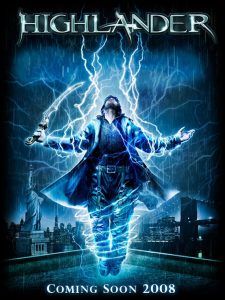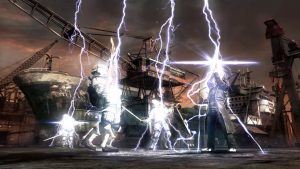Highlander is a canceled action-adventure game published by Eidos Interactive and developed by Widescreen Games, for the PC, Playstation 3 and Xbox 360, from 2006 to 2008, based on the eponymous film franchise.
Initially, the attempt to develop a new Highlander game dated back well before this one. In September 2004, the company SCi Games managed to conclude an agreement with Davis-Panzer Productions, holder of the rights of the franchise. It was then Climax Studios which was responsible for developing a prototype for the Playstation 2. However, after the takeover of SCi by Eidos Interactive in May 2005, the project was, according to former Senior Programmer Marc Fascia, given to Widescreen Games before being put on-hold in August of the same year. The development was relaunched around the end of 2006, aiming for next generation’s hardwares, and officially announced in August 2007 during the Game Convention, although already in February of the same year, the preparation of a new Highlander game was leaked. During its official revelation, several details were disclosed:
“It will be a third-person action adventure that spans over 2000 years, giving you a chance to explore feudal Japan, medieval Scotland, a futuristic vision of New York and Pompeii before the historical volcanic eruption.
Similarly to the film, the aim will be to journey around the world and meet other immortal warriors in battle, lopping off their heads to win. You’ll have the choice of Katana, Claymore or Double to use, and be able to use various techniques to overpower your foe – like Resurrection, Chi Balance, Fireblade, Wind Fury, Stone Armour and other powered-up special attacks.
You’ll be the newcommer Owen Macleod, but come face to face with 77 other characters along the way – some familiar from the television series or films.
Widescreen is promising around 18 missions to tackle in general, and lots of ways to get around your environment: zip wires, dagger and traverse climbing, swan dives, free falls, cannonballs and beams.”
More information were shared in January 2008 alongside what was, for a long time, the only official video of the game:
“Publisher Eidos has officially announced that it will be bringing an Unreal Engine 3 game based on the popular movie and TV series Highlander to Xbox 360, PlayStation 3, and PC later this year. Eidos notes that the title, to be developed by Widescreen Games, will be written by TV series writer David Abramowitz, and will take series star Owen MacLeod “on a journey across multiple lands from first century fiery Pompeii, to futuristic New York to discover his destiny and explore the powers of immortality.” By nature of that immortality, Eidos says players will be able to exploit the unique powers it brings and “manipulate situations that death would normally prevent” such as channeling electricity and fire, impaling himself on enemy weapons to disarm them and falling from buildings to escape. The game will also feature “an advanced combat system, gamers will master a variety of Highlander swords including the Claymore, Katana, and Twin Gladius” which will “combine exciting swordplay with the Quickening powers of an Immortal.” MacLeod’s knowledge and strength will be enhanced with each other Immortal he beheads throughout the game.”
In March of the same year, it was an interview with Producer Gilles Baril, which explained in detail new points about the game, including its story, that appeared online:
Could you please reveal the beginning of the game’s plot, just a glimpse of the story?
G.B.: “The game starts in New York – large parts of the city are being evacuated but nobody knows why. The hero, Owen McLeod, is about to leave the city when several heavily armed men burst into his loft apartment. As the story unfolds, Owen finds out that a powerful immortal is the leader behind the attacks, searching for a mysterious artefact which was broken many years before into three fragments. Owen sets off after the fragments, sensing that his destiny is closely linked to this ancient artefact, he racks his memories for clues, memories which will plunge him into three different key periods of his past.”
Can you describe the different environments on the game and where it all takes place historically?
G.B.: “The game takes place in modern day New York where Owen must sift through his memories in order to unfold the story. These memory flashbacks take place in: Pompeii in the 1st Century AD, where, as a young gladiator, Owen meets his mentor who teaches him of his true nature and of the rules to the Game; The Highlands in the 9th Century where, in search of his origins, he befriends a fellow Immortal named Ryan, with whom he fights side by side against the Viking ravagers allied to the powerful Pict sorcerer Barak; and finally, Japan in the 14th Century, where, with his ally Methos, he protects the sanctuary of Kusanagi-no-tsurugi, a legendary blade, and fights Shinu, Lord of the Tengus, who seeks to make off with this sacred artefact.”
In the game will you leap between different time periods in history? Will the game also include an RPG element as you progress?
G.B.: “The game moves between New York to Owen’s memories in past time periods so you’ll be moving between different time periods as Owen tries to discover the key to what is happening to him in New York. We’ve kept to a good balance of navigation, combat and story. Each environment varies in terms of balance of these three elements. This is a tricky balance to get right but we’re happy with the outcome. There will also be an element of RPG to the game as you will be able to upgrade Owen’s combat and Quickening techniques as you play through the game, depending on the choices you make as you play.”
Can you explain how you will be able to upgrade your character?
G.B.: “The player can upgrade their player character, weapons and immortal Quickening techniques in two ways – by spending experience points earned in the game and by finding secret bonuses hidden in the levels. The player can earn extra experience points by using more skilled combat moves to finish off their opponents and by completing secondary objectives in the levels (for example, saving all the innocent Scottish villagers from being slaughtered by the Vikings in the Highlands). Upgrades enhance the strength of the weapons, the power and scope of the Quickening effects and increase the abilities of the player character.”
We understand that you can move both on rooftops and on the ground in the New York part of the game. Can you explain how this happens?
G.B.: “The game features levels where navigating deadly heights is crucial. One of these levels features a wind effect which will blow the character off unless the player is careful. The New York levels are pretty vast and do feature gameplay on the ground and higher levels/roofs, however we also have to take care to ensure the player doesn’t get lost, so there are some limits.”
How does the combat system work?
G.B.: “Each weapon has its own set of attacks and the player can create their own combos. This evolves further when Owen is in Fury mode which gives him much stronger attacks. Using the Weapon Mastery Quickening technique each weapon can also become even more destructive. We’re very confident that the combat experience will be easy for players to pick up and play and will also provide a real unique Highlander flavor.”
Will you fight other Immortals?
G.B.: “There are boss fights with other Immortals but we wanted to keep the Immortal fights special so in many parts of the game Owen will be fighting mortals. Some of the mortals are aware that Owen is an Immortal and have been hired to kill him, like the men invading his apartment in New York at the start of the game, whereas others are just generally up to no good like the Vikings invading the Scottish highlands in later levels.”
However, the game, initially planned for the summer of 2008, disappeared again from the radar and was no longer mentioned. We can see that several Widescreen employees stopped working on it around the time when it was supposed to be released. In February 2009, following the economic crisis, Eidos was bought by Square Enix to become Square Enix Europe. In April of the same year, some sources declared that David Abramowitz, during a convention dedicated to Highlander told that the game was postponed indefinitely following disagreements between Eidos and Davis-Panzer. In parallel, Widescreen was already working on a new project, The Witcher: Rise of the White Wolf, before filing for bankruptcy in July 2009. Oddly enough, it was not until December 2010 that Square Enix confirmed the cancellation of the game, which could imply that after the shutdown of Widescreen, the publisher planned to relaunch the development of the game with a new developer.
It was never officially revealed why Highlander was canceled. In this comment section, an anonymous source claiming to have worked on the game indicate that it was finished but was of poor quality and would justify the delay announced by Abramowitz in April 2009, but this remains to this day only pure speculation. On the other hand, Alexis Madinier, one of the former developer on the game wrote on his LinkedIn profile that it was:
“canceled due to clash between publisher and IP Owner. At 2 months of the release…“
Which could confirm the words of David Abramowitz during the convention. No further attempts to develop a new game based on the Highlander franchise have materialized after that one for now.
Special thanks to Wavy Mavis for providing all soundtracks initially composed by Richard Jacques for the game!
Images:
Videos:
Official Highlander’ soundtrack by Richard Jacques. Thanks to Wavy Mavis and the timestamps, we can learn a bit more about the game.



![Bujingai 2 [PS2 – Cancelled] Bujingai 2 [PS2 – Cancelled]](https://www.unseen64.net/wp-content/uploads/2024/05/214647-699510256-670x300.jpg)
